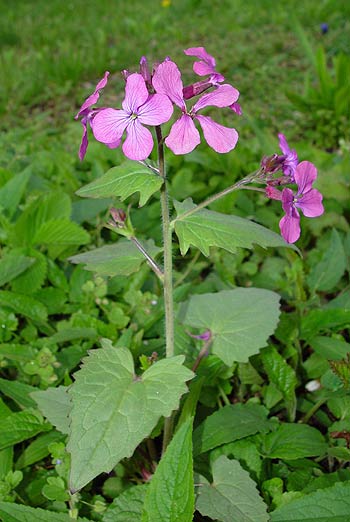
It is an annual or biennial growing to 90 cm (35 in) tall by 30 cm (12 in) broad, with large, coarse, pointed oval leaves with marked serrations. In spring and summer it bears terminal racemes of white or violet flowers, followed by showy, light brown, translucent, disc-shaped seedpods (silicles) the skin of which falls off to release the seeds, revealing a central membrane which is white with a silvery sheen, 3–8 cm (1–3 in) in diameter; they persist on the plant through winter. These pods are much used in floral arrangements.
The Latin name lunaria means "moon-shaped" and refers to the shape and appearance of the seedpods.
The common name "honesty" arose in the 16th century, and may also relate to the translucence of the seedpods.

In South East Asia, it is called the "money plant" and in the United States it is commonly known as "silver dollars", "Chinese money", or "Chinese coins" because its seedpods have the appearance of silvery coins. For the same reason, in French it is known as monnaie du pape ("the Pope's money"). In Denmark it is known as judaspenge and in Dutch-speaking countries as judaspenning (coins of Judas), an allusion to the story of Judas Iscariot and the thirty pieces of silver he was paid for betraying Christ.

This plant is easy to grow from seed. It is usually grown as a biennial, being sown one year to flower the next. It is suitable for cultivation in a shady or dappled area, or in a wildflower garden, and the flowers and dried seedpods are often seen in flower arrangements. Numerous varieties and cultivars are available, of which the white-flowered L. annua var. albiflora has gained the Royal Horticultural Society's Award of Garden Merit.

No comments:
Post a Comment